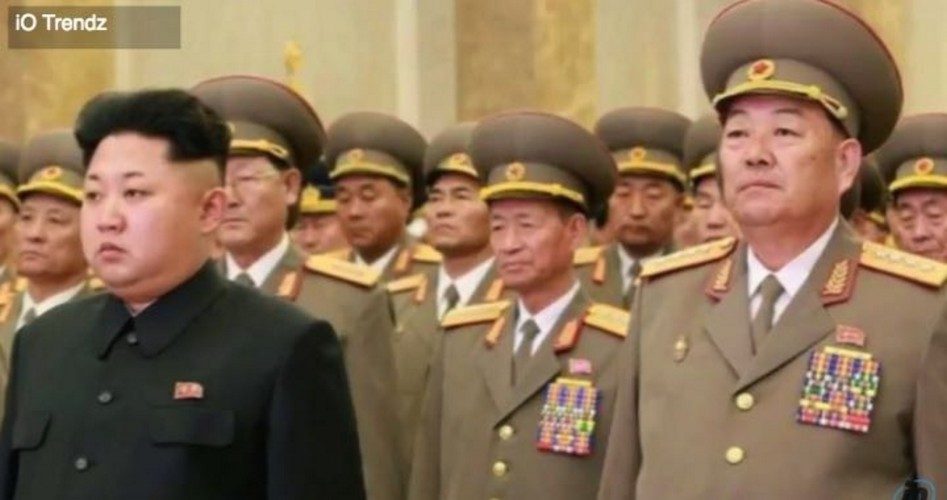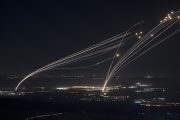
An unidentified North Korean official said on October 16 that the communist state remains committed to developing a long-range intercontinental ballistic missile (ICBM) capable of reaching “all the way to the East coast of the mainland United States.” The official made the statement to CNN, telling the news network that the Pyongyang regime is currently not interested in diplomacy with the United States until it achieves that goal.
That official said that North Korea is not ruling out diplomacy, but “before we can engage in diplomacy with the Trump administration, we want to send a clear message that the DPRK has a reliable defensive and offensive capability to counter any aggression from the United States.”
The official told CNN that two additional steps would be required for North Korea to achieve its goal of producing a reliable ICBM.
The first step is an above-ground nuclear detonation. North Korean Foreign Minister Ri Yong Ho threatened that his country might be developing such a weapon at the UN last month when he implied that Kim Jong-un was considering detonating “an unprecedented scale hydrogen bomb” over the Pacific after President Trump threatened to “totally destroy” North Korea.
The second step, said the official, would be the “testing of a long-range ICBM capable of reaching Guam — and even further.”
North Korean Deputy UN Ambassador Kim In Ryong told a UN General Assembly committee on October 16: “Unless the hostile policy and the nuclear threat of the U.S. is thoroughly eradicated, we will never put our nuclear weapons and ballistic rockets on the negotiation table under any circumstance,” reported Reuters.
Kim also warned the committee members that if they do not join the United States in military action against North Korea they will be safe from retaliation. “As long as one does not take part in the U.S. military actions against the DPRK [North Korea], we have no intention to use or threaten to use nuclear weapons against any other country,” Reuters quoted from Kim’s prepared remarks.
“The entire U.S. mainland is within our firing range and if the U.S. dares to invade our sacred territory even an inch it will not escape our severe punishment in any part of the globe,” the statement read.
A report posted by the Uproxx media company noted White House Chief of Staff John Kelly made comments last week that seemed to indicate that North Korea was closer to developing a long-range ballistic missile than previously believed. North Korea has said that it will conduct more missile tests during the five days of U.S.-South Korea naval drills that began on October 16 (which North Korea calls a preamble to a U.S.-led invasion) or during President Trump’s visit to Asia in November.
Kelly told reporters that Pyongyang “is developing a pretty good nuclear re-entry vehicle.”
The same day that the North Korean official said that Pyongyang is placing a higher priority on developing an ICBM that can reach the U.S. East Coast than it is on engaging in diplomacy with the United States, Deputy Secretary of State John Sullivan told reporters that while the State Department remained focused on reducing tensions with North Korea through diplomatic channels, the United States and world must remain prepared for the possibility that those efforts will fail. “We must, however, with our allies in Japan and South Korea and elsewhere, be prepared for the worst should diplomacy fail,” Sullivan said, according to the Associated Press.
An AOL report said that Sullivan’s remarks came after a meeting with his Japanese counterpart, Shinsuke Sugiyama, where they two discussed rising tensions in the region. The two statesmen are scheduled to travel to South Korea to continue those discussions.
Speaking on CNN’s State of the Union on October 15, Secretary of State Rex Tillerson said his diplomatic efforts will continue as long as they possibly can despite the saber-rattling emanating from both North Korea and the United States. “Those diplomatic efforts will continue until the first bomb drops,” Tillerson said.
As Pyongyang and Washington continue to alternately engage in diplomacy and threaten each other with military devastation, it is useful to remember some points we made in our article last August: “What Does the U.S.-North Korean War of Words Really Mean?”
In that article we asked if, considering that North Korea is so technologically backward that it has difficulty in maintaining its electrical grid, can anyone believe that it poses any realistic military threat against the world’s greatest superpower?
We noted that the usual explanation offered is that North Korea is a “rogue” state whose leader’s bravado exceeds his common sense. But there are more likely explanations, such as one provided by The New American’s foreign correspondent, Alex Newman, the article “North Korea: Globalist Pawn?” Far from being “alone,” the communist regime in North Korea has had friends in high places from the beginning, and still does today. First and foremost, the regime is a puppet and close ally of the powerful communist dictatorship enslaving mainland China’s 1.3 billion people — a regime that is increasingly projecting its power globally.
We reminded the reader that a history of communist aggression toward the United States since the end of World War II showed us that the communist giants — China and the old Soviet Union — have never engaged us in war directly. They, instead, operate though puppets such as North Korea and North Vietnam (and even “Islamic” terrorists who are more red than Islamic), and bog down U.S. forces in never-ending no-win wars that exhaust our resources mentally, morally, and economically.
We concluded:
The greatest threat posed by North Korea does not come from its missiles — which have been impressive during tests but are probably years away from practical operational use. A more likely development is that the conflict between Pyongyang and Washington will escalate into a second Korean War that will look much like the first Korean War. That is, a UN-directed operation against a Chinese supported enemy, where our military’s hands are tied by UN bureaucrats and victory is always elusive.
Photo of Kim Jong-un (left): Screenshot of video made by iO Trendz
Related articles:
Official Says North Korean Missile Has “.00001 Percent Chance” of Getting Through Defenses
North Korea Tests Ballistic Missile Capable of Reaching U.S. Base on Guam
In Test That Will Send Message to N. Korea, U.S. Successfully Intercepts ICBM
Successful Test of THAAD Anti-missile System Offers Hope for U.S. Defense
South Korea Says North Korean ICBM Lacks Re-entry Capability
Aircraft Carriers Gather Off N. Korea; Pyongyang Tests Missile Able to Hit Ships
Recently Tested North Korean ICBM Said to be in Range of Most of U.S.
N. Korea Continues Missile Tests; U.S. Moves 3rd Carrier Strike Force to Western Pacific
North Korea Tests Another Missile, Says They Are Ready to Deploy
North Korea Threatens U.S. With “All Out War” and “Weekly Missile Tests”
North Korea Threatens to Attack U.S. Carrier Group; Detains U.S. Citizen
North Korea Warns of Nuclear Retaliation at Any Sign of U.S. “Aggression”
North Korea Admits Missile Launches Were Test of Possible Strike Against U.S.Bases in Japan



